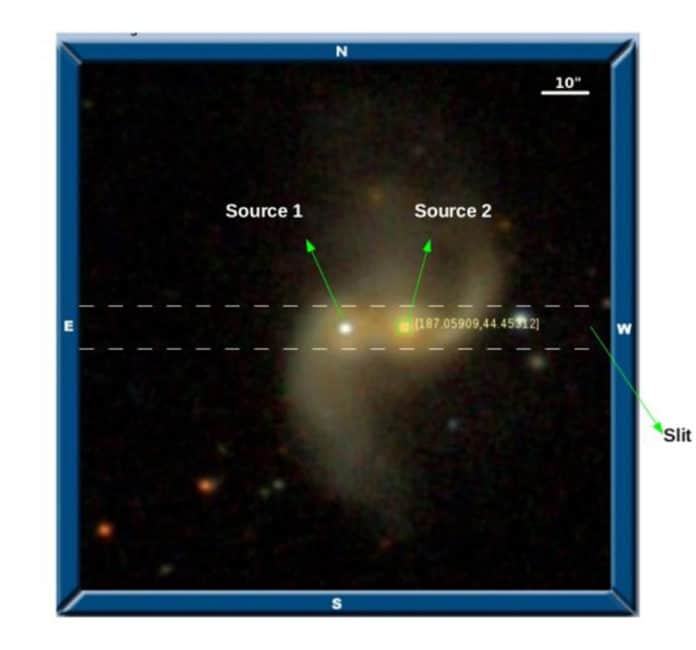After conducting multi-wavelength observations of a galaxy merger remnant known as Mrk 212, using the Karl G. Jansky Very Large Array (VLA) and the upgraded Giant Meter Radio Telescope (uGMRT), astronomers found that gas inflow during galaxy mergers can trigger mass accretion onto the supermassive black holes (SMBHs), turning them into active galactic nuclei (AGN).
If two SMBHs ignites at the same time, it may form AGN pairs. If the separation between the two AGN is less than 326 light-years, they are known as binary AGN. In the case that the separation is more significant, astronomers call them dual AGN.
Mrk 212 is a galaxy merger remnant, located at a luminosity distance of about 322 million light-years. The merger remnant has two known radio sources associated with two optical nuclei, designated S1 and S2.
The projected separation between the two nuclei is estimated to be around 18,250 light-years, making it a dual AGN candidate.
A team of astronomers led by Khatun Rubinur of the Indian Institute of Astrophysics in Bangalore, India, made deep radio, optical and ultraviolet observations of Mrk 212 using VLA and uGMRT. The main goal of this monitoring campaign was to confirm the object’s dual AGN nature and to provide more insights into the properties of this source.
Astronomers noted, “We have carried out a multi-wavelength study of the merging galaxy Mrk 212 that possesses two optical nuclei S1 and S2 at a projected separation of ∼ 11.8” or ∼ 6 kpcs.”
The observations from VLA revealed that a double radio source associated with S1 and a compact radio structure associated with S2. The VLA images also show an extended radio structure at 8.5 GHz that, located one arcsecond away from the S2 optical nuclei, which has a relatively flat spectral index and is assumed to be a compact core.
The total extent of S1 is about 2,445 light-years, and its average 1.4−8.5 GHz spectral index is at a level of approximately −0.81. These properties mean that S1 resembles a compact symmetric object (CSO).
According to the study, the presence of the compact radio core and the presence of AGN emission lines in the optical spectrum of S2 suggest the presence of another AGN in S2. Moreover, the optical observations show that S1 and S2 both fall in the AGN+SF (star formation) region in the BPT (Baldwin, Philips, and Terlevich) diagram. The astronomers concluded that the obtained results strongly support the dual AGN nature of Mrk 212.
Journal Reference:
- Rubinur et al., A Multi-wavelength Study of the Dual Nuclei in Mrk 212, arXiv:2010.14914 [astro-ph.GA] arxiv: 2010.14914
